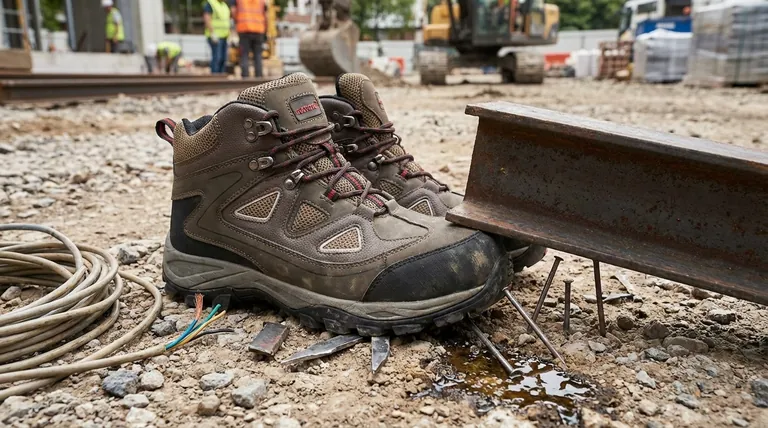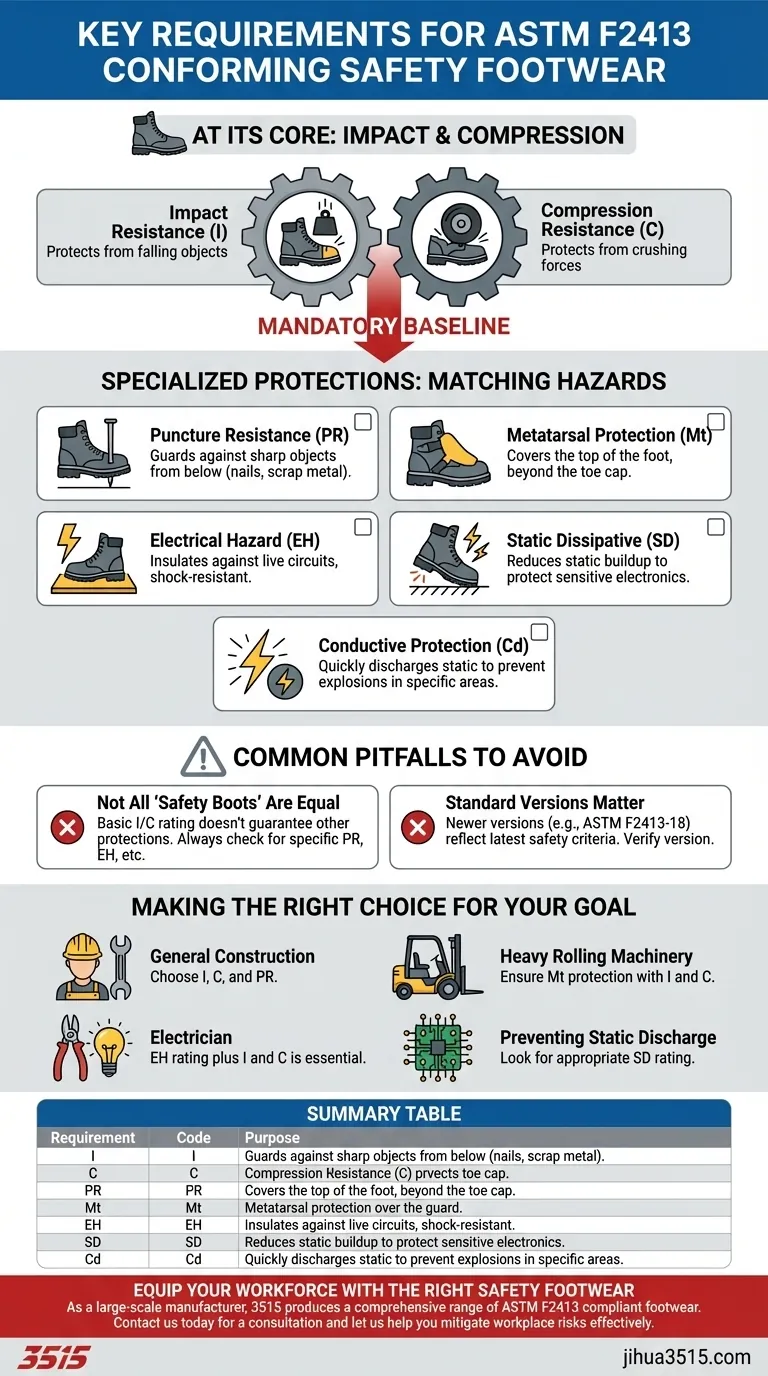At its core, ASTM F2413 conforming safety footwear must meet mandatory requirements for impact and compression resistance in the toe area. Beyond this foundation, the standard outlines several additional protections for specific workplace hazards, such as puncture resistance and electrical insulation, which are not required for all certified footwear.
The critical takeaway is that ASTM F2413 establishes a baseline for safety with impact and compression resistance, but it's the specific, additional ratings on the footwear's label that tell you if it protects against the unique hazards of your environment.

The Foundation: Mandatory Safety Requirements
Any piece of footwear bearing the ASTM F2413 mark must first pass two fundamental tests. These form the non-negotiable core of the safety standard.
Impact Resistance (I)
This requirement ensures the protective toe cap can withstand the force of a heavy object falling onto the foot. It is a fundamental feature for environments where items can be dropped.
Compression Resistance (C)
This standard tests the toe cap's ability to protect the foot from being crushed by a slow-moving, heavy, rolling object. This is crucial in workplaces with heavy machinery or rolling equipment.
Specialized Protections for Specific Hazards
After meeting the mandatory I/C requirements, footwear can be certified for additional protections. These are specified on the label and must be matched to the known risks of a job.
Puncture Resistance (PR)
Footwear with a PR rating includes a puncture-resistant plate built into the sole to protect the foot from sharp objects from below, such as nails or scrap metal.
Metatarsal Protection (Mt)
This provides an added guard that covers the top of the foot (the metatarsal bones). It protects against impacts to an area that a standard toe cap does not cover.
Electrical Hazard (EH)
EH-rated footwear is designed to provide a secondary source of protection by insulating the wearer from live electrical circuits. It is made with non-conductive, shock-resistant soles and heels.
Static Dissipative (SD)
SD footwear is constructed to reduce the buildup of static electricity by conducting it safely to the ground. This is vital in environments where a static discharge could damage sensitive electronics or ignite flammable materials.
Conductive Protection (Cd)
Conversely, conductive footwear is designed to discharge static electricity from the body through the shoes into the ground very quickly. This is used in highly specific environments where the rapid discharge of static is essential to prevent explosions.
Common Pitfalls to Avoid
Understanding the standard's structure is key to avoiding common and potentially dangerous misconceptions.
Not All "Safety Boots" Are Created Equal
A boot can be ASTM F2413 compliant with only the basic Impact (I) and Compression (C) ratings. If your job requires protection from punctures or electrical shocks, you must verify the boot has the specific PR or EH rating on its label.
The Importance of the Standard's Version
The standard is periodically updated (e.g., ASTM F2413-11 vs. ASTM F2413-18). Newer versions reflect the latest safety criteria and testing methodologies. Always check the specific version to ensure you are getting protection that aligns with current best practices.
Making the Right Choice for Your Goal
Always select footwear based on a thorough hazard assessment of your specific work environment.
- If your primary focus is general construction: Choose a boot rated for Impact (I), Compression (C), and Puncture Resistance (PR).
- If your primary focus is working with heavy rolling machinery: Ensure your footwear includes Metatarsal (Mt) protection in addition to I and C.
- If your primary focus is work as an electrician: Your footwear must have an Electrical Hazard (EH) rating along with the I and C base requirements.
- If your primary focus is preventing static discharge: Look for a Static Dissipative (SD) rating appropriate for your environment.
Ultimately, understanding the specific codes on the label empowers you to select footwear that provides targeted protection for the real risks you face.
Summary Table:
| Requirement | Code | Purpose |
|---|---|---|
| Impact Resistance | I | Protects from falling objects |
| Compression Resistance | C | Protects from crushing forces |
| Puncture Resistance | PR | Guards against sharp objects from below |
| Metatarsal Protection | Mt | Protects the top of the foot |
| Electrical Hazard | EH | Insulates against live circuits |
| Static Dissipative | SD | Reduces static electricity buildup |
| Conductive Protection | Cd | Quickly discharges static electricity |
Ensure your workforce is equipped with the right safety footwear for their specific hazards. As a large-scale manufacturer, 3515 produces a comprehensive range of ASTM F2413 compliant footwear for distributors, brand owners, and bulk clients. Our production capabilities encompass all types of safety shoes and boots, ensuring you get durable, certified protection tailored to your needs. Contact us today for a consultation and let us help you mitigate workplace risks effectively.
Visual Guide

Related Products
- Safety Footwear Wholesale Manufacturer for Custom OEM/ODM Production
- Wholesale Safety Footwear Manufacturer for Bulk & Custom OEM Orders
- Premium Suede Sport Safety Shoes for Wholesale & Bulk Orders
- Wholesale Customizable Safety Boots Durable & Protective Footwear Manufacturing
- Heavy Duty Nubuck Safety Boots Safety Shoes for Global Distribution
People Also Ask
- What are OSHA approved shoes? Understanding the Correct Standards for Workplace Safety
- What are the cultural perspectives on wearing shoes in the house? A Guide to Home Etiquette & Hygiene
- What cultural and environmental considerations are tied to wearing shoes indoors? Balance Hygiene, Tradition, and Foot Health
- Is it normal to wear shoes in the house? A Guide to Hygiene, Comfort & Culture
- Do snake bite boots work? Your Ultimate Guide to Effective Snake Bite Protection



















